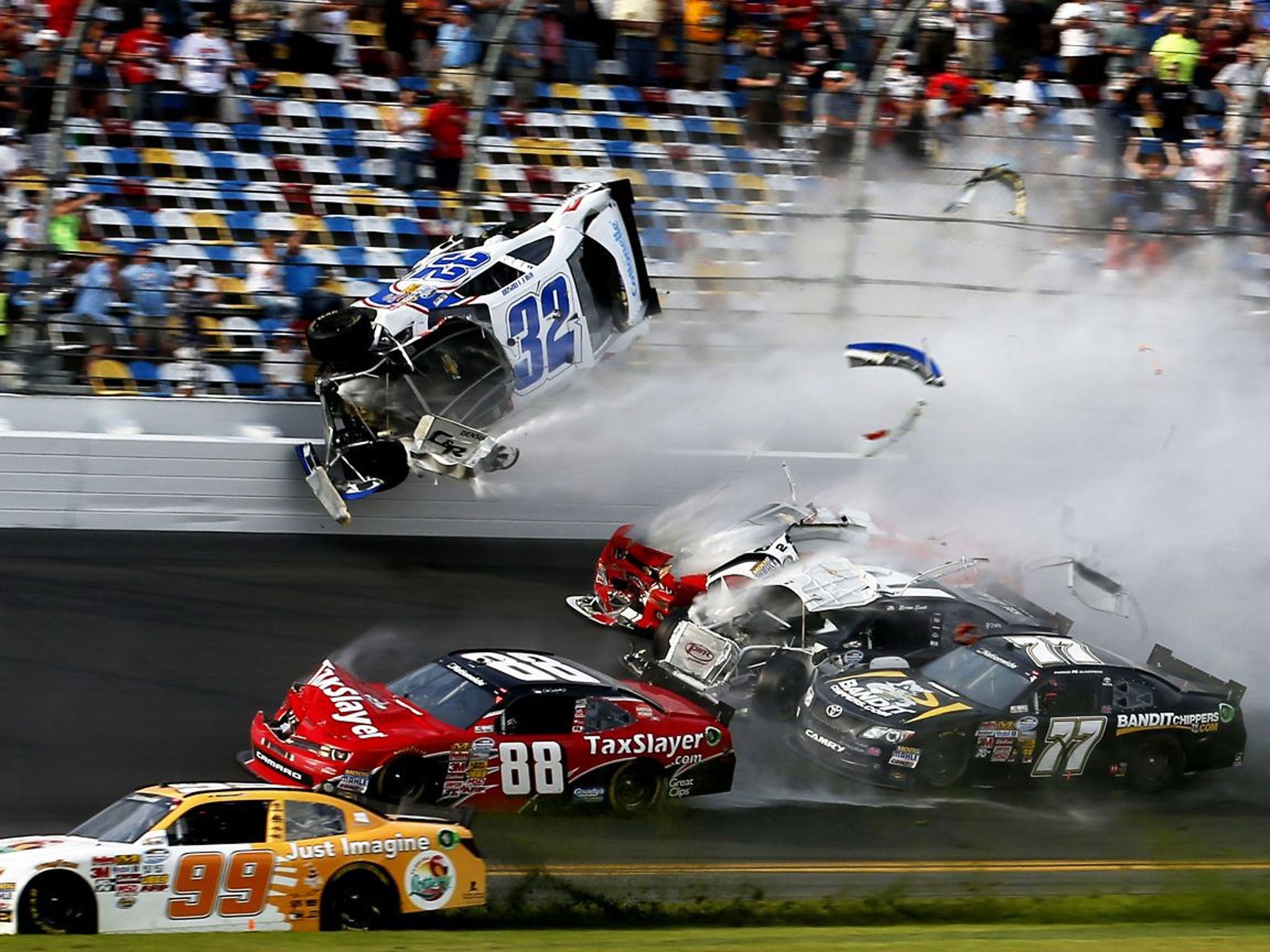
Your support helps us to tell the story
From reproductive rights to climate change to Big Tech, The Independent is on the ground when the story is developing. Whether it's investigating the financials of Elon Musk's pro-Trump PAC or producing our latest documentary, 'The A Word', which shines a light on the American women fighting for reproductive rights, we know how important it is to parse out the facts from the messaging.
At such a critical moment in US history, we need reporters on the ground. Your donation allows us to keep sending journalists to speak to both sides of the story.
The Independent is trusted by Americans across the entire political spectrum. And unlike many other quality news outlets, we choose not to lock Americans out of our reporting and analysis with paywalls. We believe quality journalism should be available to everyone, paid for by those who can afford it.
Your support makes all the difference.A horrifying crash on the last lap of a race at Daytona International Speedway injured at least 30 fans yesterday and provided another stark reminder of what can happen when a car going nearly 200 mph is suddenly launched toward the spectator areas.
The victims were sprayed with large chunks of debris - including a tyre - after newcomer Kyle Larson's machine hit fencing that is designed to protect the massive grandstands lining Nascar's most famous track.
"I love the sport," said Shannan Devine, who witnessed the carnage from her 19th-row seat, about 250 feet away. "But no one wants to get hurt over it."
The fencing served its primary purpose, catapulting what was left of Larson's car back on to the track. But it did not keep potentially lethal shards from flying into the stands.
"There was absolute shock," Ms Devine said. "People were saying, 'I can't believe it, I can't believe it. I've never seen this happen, I've never seen this happen. Did the car through the fence?' It was just shock and awe. Grown men were reaching out and grabbing someone, saying, 'Oh my gosh! Oh my gosh!' It was just disbelief, absolute disbelief."
From Daytona to Le Mans to a rural road in Ireland, auto racing spectators have long been too close to the action when parts start flying. The crash in the second-tier Nationwide race follows a long list of accidents that have left fans dead or injured.
The most tragic incident occurred during the 1955 24 Hours of Le Mans, when two cars collided near the main stands. The wreck sent debris hurtling into the crowd, while one of the cars flipped upside down and exploded in a giant fireball.
Eighty-three spectators and driver Pierre Levegh were killed, and 120 fans were injured.
The Daytona crash began as the field approached the checkered flag and leader Regan Smith attempted to block Brad Keselowski. That triggered a chain reaction, and Larson hit the cars in front of him and went airborne into the fence.
The entire front end was sheared off Larson's car, and his burning engine was wedged through a gaping hole in the fence. Chunks of debris from the car were thrown into the stands, including a tyre that cleared the top of the fence and landed midway up the spectator section closest to the track.
"I thought the car went through the fence," Ms Devine said. "I didn't know if there was a car on top of people. I didn't know what to think. I'm an emotional person. I immediately started to cry. It was very scary, absolutely scary. I love the speed of the sport. But it's so dangerous."
The fencing used to protect seating areas and prevent cars from hurtling out of tracks has long been part of the debate over how to improve safety.
Three-time Indianapolis 500 winner Dario Franchitti lost close friend Dan Wheldon at Las Vegas in the 2011 IndyCar season finale, when Wheldon's car catapulted into the fencing and his head struck a support post. Since his death, IndyCar drivers have called for studies on how to improve the safety barriers.
Franchitti renewed the pleas on Twitter after the Daytona crash, writing "it's time (at)Indycar (at)nascar other sanctioning bodies & promoters work on an alternative to catch fencing. There has to be a better solution".
Another fan who witnessed the crash said he has long worried that sizable gaps in the fencing increase the chances of debris getting through to the stands.
"I've always thought the netting was very wide and pieces could fly through," said Lenny Brown, who was attending races at Daytona for the fourth time.
Workers scurried to patch up the damaged fencing and left little doubt that the biggest race of the weekend, the Daytona 500, would go on as planned.
Mr Brown, who saw the crash from his 38th-row seat in the Petty grandstand, said he would be back in the same section for the season-opening Sprint Cup event. He has no qualms about his safety, sitting so high up, but said he would think twice about the seats he had for the race two years ago.
"The last time I was here, we were only about six rows up," Mr Brown said. "I had even told some people before the crash, 'I would never sit that close to the track ever again."'
But someone surely will - mindful of the risks but eager to be among more than 100,000 fans cheering on stock car racing's biggest stars.
"Here we are, paying money to sit next to cars going 195 mph," Ms Devine said. "We do it because we love it. That's what we expect."
AP
Join our commenting forum
Join thought-provoking conversations, follow other Independent readers and see their replies
Comments